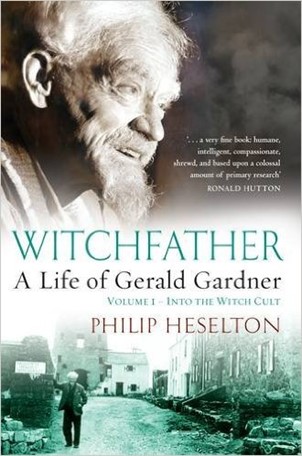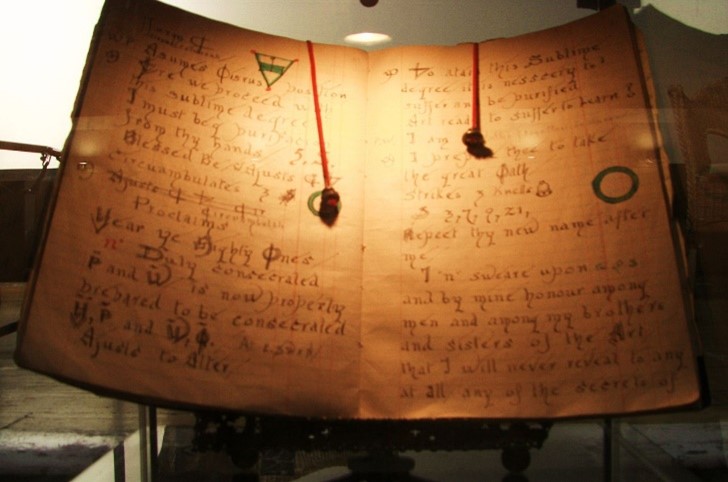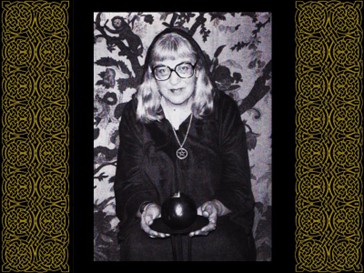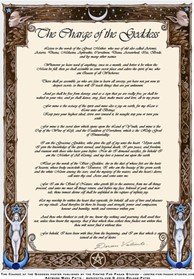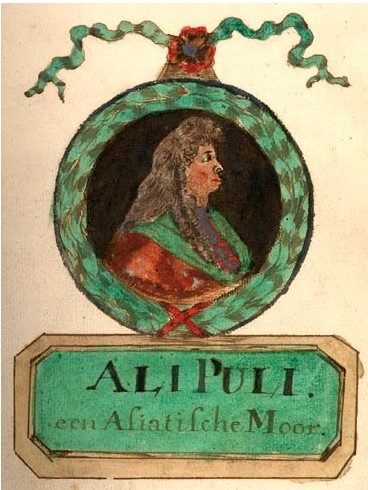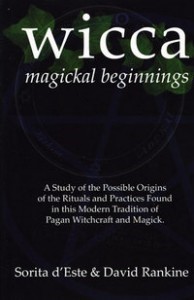Paper by Morgana, Utrecht, the Netherlands, October 2016, (Revised December 2022)
“Wicca” is a prime example of a revival of ritual practice and custom, primarily in the British Isles. ‘Wicca’, or Modern Witchcraft / Pagan Witchcraft, as a name, was introduced in the 1950’s by Gerald B. Gardner after the Witchcraft laws of 1735 were revoked and replaced by the Fraudulent Mediums Act (1951). What motivated Gerald Gardner to revive “The Old Religion”? Which resources in the re-establishment or revival of these dormant customs did he use? In recent discussions about Neo-paganism, where there is a tendency to claim authenticity, it has become more and more apparent that to understand the nature of “Wicca” we need to look at the cultural and social environment of England in the 1950’s. The pagan/heathen heritage in Europe does indeed go back millennia, but Wicca is clearly a product of modernity.
In this paper, I will be looking at the impact of cultural influences and how Wicca has developed in Europe over the last 50 + years.
Introduction: Good afternoon, my name is Morgana, and I would like to read my paper as a Gardnerian Wiccan priestess, a practitioner, in other words, of the religion of Wicca, as an insider.
What is Wicca? “Wicca” is a prime example of a revival of ritual practice and custom, primarily in the British Isles. ‘Wicca’, also referred to as Initiatory Wicca, Modern Witchcraft or Pagan Witchcraft, as a name was introduced in the 1950’s by Gerald B. Gardner after the Witchcraft laws of 1735 were revoked and replaced by the Fraudulent Mediums Act (1951). What motivated Gerald Gardner to revive “The Old Religion”? The name the Old Religion was sometimes used to differentiate it from the NEW Religion, or Christianity.
It was his curiosity and love of folklore which inspired him to delve into the life and customs of country folk. Even as a Civil Servant in Ceylon (Sri Lanka) in 1900 and later in Malaya in 1911, he was fascinated by the indigenous folk, particularly the Dayaks, He made a study of the sacred dagger – the Kris – which was published as “The Keris and other Malay Weapons” (1936) and which is still regarded as an authoritative work.
However, it wasn’t until his retirement and return to Europe that Gardner continued his search for ancient native spiritual practices in earnest. Although he and his wife Donna returned to London in 1936, it wasn’t long before he became involved in archaeological excavations in Palestine. On his return to England, he decided to join a nudist club on the recommendation of his doctor Edward A. Gregg. This brought him in contact with Fouracres, a nudist club near to Bricket Wood in Hertfordshire.
Biographer Philip Heselton suggests that it was the contacts Gardner made there and during that period that led him to discover Wicca/Witchcraft. Becoming part of an active group (possibly Coven), Gardner was finally in touch with people who were “part of an ancient cult”, as he described it later to one of his High Priestesses, Doreen Valiente.
For an extensive look into Gardner’s life, please refer to Philip Heselton’s books, especially Witchfather: A Life of Gerald Gardner. Vol 1 and Vol II
Which resources in the re-establishment or revival of these dormant customs did he use?
As noted, Gardner was well-travelled and interested in many different cultures. He also authored a number of books, his first under the pseudonym of Scire. “High Magic’s Aid” (1949). Written as a novel, Gardner uses a number of texts which are later found in the so-called Gardnerian Book of Shadows, which is the handbook of rituals used by Gardnerians. In 1949 the Witchcraft laws were still in place, and it was only after 1951 that one could write as an insider. (Although Gardner and other authors such as Doreen Valiente still wrote post-1951 as having spoken with informants.)
Regarding the Gardnerian BoS, which is now available as a public version on Sacred-texts.com, the following can be read;
“The Book of Shadows was attributed by Gardner to an ancient, clandestine witch cult, which he claimed to have been initiated into. However, modern researchers have concluded that it was composed by Gardner. The text shows influences from English and
Celtic Folk-lore, the Enochian system of John Dee, Thelema, the Golden Dawn, Stregaria, Tantric Yoga, the KJV Bible and even Kipling. This version organizes the material in chronological order and has estimated dates for each section, ranging from 1949 to 1961.”
I have seen an original book which Gardner compiled. It is part of the Doreen Valiente collection which in turn is now owned by the “Doreen Valiente Foundation”. It was also featured in the exhibition in Brighton in April 2016
(One of Gerald Gardner’s earliest Books of Shadows.)
It is a collection of quotes mainly from the “Key of Solomon”, and other occult works, for example from Aleister Crowley.
One of the reasons that this book is in the Doreen Valiente collection is because it was Doreen who was responsible for “cleaning up” the texts. In her book The Rebirth of Witchcraft, she writes:
“. . with the publication of his book Witchcraft Today in 1954 and his lectures and appearances on television, more and more people began contacting Gerald and wanting to join. Gerald began to realize that he had a real chance of reviving the Old Religion, and he wanted to gain popular acceptance for it. I pointed out to him that, in my opinion, he would never succeed in doing this so long as the influence of the late Aleister Crowley was so prevalent and obvious within the cult . . . Crowley may have been a brilliant writer and a splendid poet, but as a person, he was simply a nasty piece of work. His great importance in the occult world was that he had wrenched open that treasure chest in which the order of the Golden Dawn had locked up in the secret knowledge of the Western Mystery Tradition and had invited all to share the treasure.
Gerald’s reaction was, ‘Well, if you think you can do any better, go ahead.’ I accepted the challenge and set out to rewrite ‘The Book of Shadows,’ cutting out the Crowleyanity as much as I could and trying to bring back to it what I felt was, if not so elaborate as Crowley’s phraseology, at least our own and in our own words. I felt that the words from Aradia qualified in this respect, so I retained them as the basis for my new version of ‘The Charge’. .”
Doreen was referring to Aradia, or the Gospel of the Witches by Charles G. Leland (1899) and in particular to the section when Aradia addresses her pupils…
Quando io saro partita da questo mondo,
Qualunque cosa che avrete bisogna,
Una volta al mese quando la luna
E piena…
[When I shall have departed from this world,
Whenever ye have need of anything,
Once in the month, and when the moon is full,]
Doreen originally re-wrote “The Charge” in verse but later compiled the prose version.
In 2009 the 10th anniversary of Doreen’s death was celebrated with “The Day for Doreen”. (September 13th 2009, Conway Hall, London). As part of the celebrations, a video collage was made of the Charge being recited in 12 different languages. I included this in the talk I gave, in which I also included part of the analysis of the text I had made.
(See the links to the video clips on Youtube below.)
In the Charge, I was able to trace influences not only from Aradia but also from Aleister Crowley. Doreen may not have liked Crowley as a person, but she still included his poetry, for example
Liber Cordis Cincte Serpente: Liber LXV, Chapter 3, part 62: “They that ever desired Thee shall obtain Thee, even at the End of their Desire.”
Or from The Book of the Law/ Liber AL vel Legis:
“I give unimaginable joys on earth: certainty, not faith, while in life, upon death; peace unutterable, rest, ecstasy; nor do I demand aught in sacrifice.”
Other influences/quotes include The Gayatri Mantra:
The William Quan Judge translation:
“Unveil, O Thou who givest sustenance to the Universe, from whom all proceed, to whom all must return, that face of the True Sun now hidden by a vase of golden light, that we may see the truth and do our whole duty on our journey to thy sacred seat.”
My favourite, though (coming from the Netherlands..), had to be the discovery of the inclusion of a quote from Ali Puli.
“If anyone should come to know the Little World properly, then nothing of the Greater World would remain unknown to him … I say to you, my disciples in the study of Nature, if you do not find the thing for which you are seeking, in your own self, much less will you find it outside yourself. Understand the glorious strength resident in your own selves. Why trouble to enquire from another?”
In the essay “1735 portrait of Ali Puli – ‘Ali Puli een asiatische Moor’ – by Burghard de Groot, he writes:
“Ali Puli was likely the nom de plume for Johann Otto von Hellwig (or von Hellbig), and the Centrum naturae concentratummanuscript – formerly owned and used by J.W. Hamilton-Jones for his 1951 translation into English under the title, The Epistles of Ali Puli (circa 1700 A.D.)– now resides in the Bibliotheca Philosophica Hermetica in Amsterdam.” (Update, it is probal
It is the text “The Charge of the Goddess” which has become the most popular of all Wiccan liturgy and it is perhaps the best example of how Wicca as a modern religion has drawn upon many sources. Not only Gerald Gardner but Doreen – and others – have been inspired by existing texts which were available to them during the first half of the 20th century.
In the book “Wicca – Magickal Beginnings: A Study of the Possible Origins of the Rituals and Practices Found in this Modern Tradition of Pagan Witchcraft and Magick” Sorita d’Este & David Rankine have done extensive research into the background of the major aspects of Wicca practice.
Their conclusions:
- that the Wiccan Tradition is a continuation of the grimoire tradition;
- the Wiccan tradition is the continuation of a Victorian ceremonial magick system;
- the Wiccan Tradition was the creation of Gerald Gardner and his associates;
- that the Wiccan tradition is the survival of a British folk magick system; or
- that the Wiccan tradition is the final form of a tradition of European witchcraft with its roots in classical Greece and Rome.
Whilst Sorita & David regard the first 3 as the most likely conclusions, I personally think all five conclusions contain some truth.
That Gerald Gardner and Doreen Valiente, as luminaries, were well-versed in classical mystery traditions and folklore is apparent. That they, like the Dutch Libertines, inspired people to share in the struggle for greater intellectual freedom of thought and expression is beyond doubt. That Wicca is a product of modernity and the renewed interest in the ‘Divine Feminine’ is also clear.
The fact that Wicca has greatly influenced the neo-pagan movement is evident. In recent years the words wiccanate, wiccanesque have been introduced to describe rituals from any pagan/heathen traditions which contain primary Wiccan elements, such as the drawing of a circle, calling the 4 wind directions (East, South, West, and North) and the recognition of a duo- polytheistic godhead.
That none of the above is actually new and can be recognised in many older traditions would certainly indicate that indeed “Wicca is .. a modern religion in an old robe…”
Thank you for your attention.
REFERENCES:
- Gardner, Gerald B. (1936) Keris and Other Malay Weapons (Bibliotheca Orientalis: Malaya-Indonesia) this edition Orchid Press (ISBN 978-9-74830-429-8)
- ——— (2010) [1949]. High Magic’s Aid (fiction). Aurinia. ISBN978-0-9566182-0-7.
- Heselton, Philip(2000). Wiccan Roots. Capall Bann. ISBN 978-1-86163-110-7.
- ——— (2003). Gerald Gardner and the Cauldron of Inspiration: An Investigation Into the Sources of Gardnerian Witchcraft. Capall Bann. ISBN978-1-86163-164-0.
- ——— (2012a). Witchfather: A Life of Gerald Gardner. Vol 1: Into the Witch Cult. Loughborough, Leicestershire: Thoth. ISBN978-1-870450-80-5.
- ——— (2012b). Witchfather: A Life of Gerald Gardner. Vol 2: From Witch Cult to Wicca. Loughborough, Leicestershire: Thoth. ISBN978-1-870450-79-9.
- Leland, Charles G. (1899) Aradia, or the Gospel of the Witches Cosimo Classics; First Edition (April 1, 2007) ISBN-13:978-1602063020
- Rankine, David and d’Este, Sorita “Wicca – Magickal Beginnings: A Study of the Possible Origins of the Rituals and Practices Found in this Modern Tradition of Pagan Witchcraft and Magick” (2008) Avalonia Books ISBN 978-1-905297-15-3
- Valiente, Doreen (1989) The Rebirth of Witchcraft Robert Hale; Second Printing edition (May 28, 2008) ISBN-13:978-0709083696
Gardnerian BoS/ Book of Shadows, public version: http://www.sacred-texts.com/pag/gbos/index.htm
Photo of the Gardner Book of Shadows: (accessed Dec 2022)
Doreen Valiente Foundation: http://www.doreenvaliente.com/
Including the Charge of the Goddess poster, art work by marc Potts. http://www.shop.doreenvaliente.org/charge-of-the-goddess-poster
Centre of Pagan Studies: http://www.centre-for-pagan-studies.com/
Morgana, (2009) The Charge of the Goddess – an interview with Morgana, 2012:
PFI (2009) The Charge of the Goddess – A multilingual Project by PFI/ Pagan Federation International, 2012: https://www.youtube.com/watch?v=t62KiwmE2Cg
Crowley, Aleister Liber Cordis Cincti Serpente Vel LXV Sub Figura Full text: http://www.sacred-texts.com/oto/lib65.htm (accessed September 2009, January 2016, December 2022)
Crowley, Aleister The Book of the Law/ Liber AL vel Legis: http://www.sacred-texts.com/oto/engccxx.htm (accessed September 2009, January 2016, December 2022)
de Groot, Burghard (2013) 1735 portrait of Ali Puli – ‘Ali Puli een asiatische Moor’: http://thefirelizard.wordpress.com/tag/centrum-naturae-concentratum/ (accessed April 2013, January 2016, December 2022)
“What ‘Wiccanate’ actually means” March 4, 2014: http://thespiae.oddmodout.com/2014/03/04/what-wiccanate-actually-means/ (accessed April 2014 and January 2016, December 2022)
“Wiccanate Privilege Discussion at Pantheacon”: http://www.patheos.com/blogs/allergicpagan/2014/02/22/wiccanate-privilege-discussion-at-pantheacon/ (accessed April 2014 and January 2016, December 2022)

